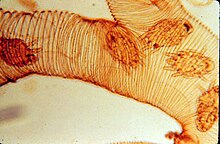Acarapiose
Acarapiose (also known as tracheal mite disease) is a disease of adult bees caused by mites , especially the honeybees Apis mellifera . The original host is probably the eastern honey bee Apis cerana .
Pathogen
The parasitic tracheal mite ( Acarapis woodi ) from the family Tarsonemidae lives in the front pair of tracheas (breathing opening) of the adult bee (inner mite) and hinders the bee's breathing, it becomes weak and unable to fly. The tracheal mite is approx. 0.1 mm in size and has strong and long drag bristles on the hind legs, all legs have strong claws, the mouthparts are piercing and sucking.
Acarapis woodi has a large distribution area and occurs in almost all countries in Europe (exception: northern states such as Denmark , Scandinavia ) and the world. It has not yet been detected in Australia . In recent years there has been an epidemic occurrence in North America .
The Isle of Wight Disease (IoWD), which was first observed on the British Isle of Wight , was initially thought to be caused by these mites. Apparently, however, diseases caused by different pathogens used to be mixed up. Today, on the other hand, the " chronic bee paralysis virus " (CBPV) is considered to be the causative agent of IoWD.
Reporting requirement
In Austria, acarapidosis is one of the notifiable animal diseases , in Switzerland it is one of the animal diseases of group 4.
Section 14 of the German Bee Disease Ordinance provides that all bee colonies must be treated by the beekeeper at the affected stand. The competent veterinary office can order the treatment of all bee colonies in an area determined by it.
literature
- Wolfgang Ritter : Diseases of bees. Ulmer, Stuttgart 1994, ISBN 3-8001-7289-5 .
Web links
- Bavarian State Institute for Viticulture and Horticulture (Ed.): Tracheal mite disease (Acarapiose) ( Memento from July 5, 2010 in the Internet Archive ) (PDF file, 30 kB)
Individual evidence
- ↑ Federal Food Safety and Veterinary Office of Switzerland: Tracheal mite disease (Acarapis woodi) , last change July 5, 2017
- ↑ Taro Maeda, Yoshiko Sakamoto: Tracheal mites, Acarapis woodi , greatly increase overwinter mortality in colonies of the Japanese honeybee, Apis cerana japonica , in: Apidologie Volume 47, pp. 762–770, 2016, doi: 10.1007 / s13592-016- 0434-x
- ↑ Yoshiko Sakamoto, Taro Maeda, Mikio Yoshiyama, Jeffery S. Pettis: Differential susceptibility to the tracheal mite Acarapis woodi between Apis cerana and Apis mellifera , in: Apidologie Volume 48, pp. 150–158, 2017, doi: 10.1007 / s13592- 016-0460-8
- ↑ a b Bee diseases. Retrieved January 29, 2017 .
- ^ Bailey L & Ball BV: Honey Bee Pathology . Academic Press, January 1991, ISBN 978-0-12073481-8 , p. 119.
